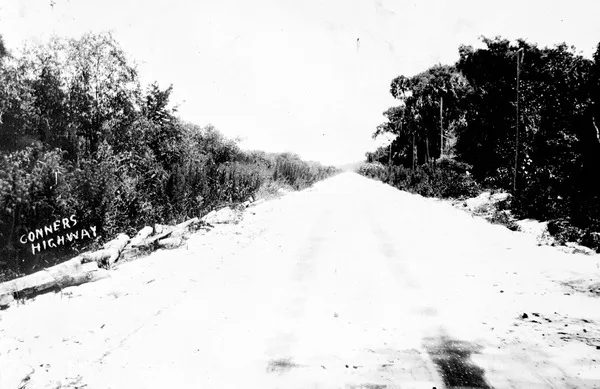
Between 1915 and 1930, there was perhaps no more substantial issue in Florida than the quality of roads. The opening of the first paved road through the Everglades in 1924 was a turning point for South and Central Florida.
It was Independence Day 1924 in Okeechobee, Florida. An estimated 20,000 people filled the streets of a town with just 1,500 residents. The Miami Herald described the celebration as a “sea of humanity” as people streamed into the frontier town around noon to kick off the dual celebration of July 4th and the grand opening of Conners Highway.
Both sitting governor Cary A. Hardee and governor-elect John W. Martin were in attendance. The festivities included a concert from the local orchestra, a 20-float parade, 300 car motorcade, fireworks (delayed until the next day due to rain), and a bevy of distinguished speakers.
During his address, Governor Hardee extolled William J. Conners’ marvelous road through the Everglades as an accomplishment on par with Henry Flagler’s famed railroad spanning Florida’s entire east coast or that of Henry Plant’s on the west coast.
Conners was able to accomplish the ambitious engineering feat, which many told him was impossible, out of pure will — and a lot of money. From start to finish, the construction took just eight months to complete the 52-mile highway. The span connected Twenty Mile Bend (20 miles west of West Palm Beach) to Canal Point on the eastern shore of Lake Okeechobee and then hugged its eastern banks up to Okeechobee City.

Virtually the entire trek traversed the thickest, most impassible muck imaginable. Much of the section along the big lake was entirely underwater! Conners was a tough, plain-speaking business mogul from Buffalo, New York. Between his gruff personality, the insanely quick deadlines he imposed, and the inhospitable conditions, the Irishman cycled through several chief engineers before landing on R. Y. Patterson.
Patterson embraced the challenge. He and his team had to raise the 24-foot-wide roadbed from the marsh for almost the entire length. They dredged sand and muck and shuttled in rocks and fill over top of a temporary railroad put in for that purpose. Improvised phone lines were strung to facilitate communication and allow teams to work around the clock.

The magnitude of the road’s importance was undeniable. At the time, there was no paved cross-state route south of Orlando nor a railway. Roadways much south or east of the Lake Wales Ridge were “unpredictable,” to say it nicely. Paths varied from sugar sand to quick-sand-like muck. Even the solid roads were known to be deeply rutted and riddled with spring-breaking potholes and bumps. Other sections could be completely underwater.
Driving from South Florida to the west coast was a crap shoot. Conditions of the various country roads were always somewhat of an unknown, requiring you to obtain advice from locals. A trip from Palm Beach to Tampa took anywhere from 11 to 24 hours — if not wholly impervious during the rainy season. Smart drivers would instead detour north via New Smyrna Beach and Sanford or through Palatka and Ocala and then back down.

It should surprise no one to hear that the $1.8 million privately-funded Conners’ Highway far out-paced state projects. After the completion of the Palm Beach to Okeechobee connection, motorists had to wait for the completion of State Road 8 from Sebring to Okeechobee and the opening of the Harding Memorial Bridge over the Kissimmee River. In 1925 this public stretch completed the paved cross-state thoroughfare to the delight of all.

The joy over the direct and sure east-to-west path only lasted a couple of years. Then frustration began to mount over paying the toll of $1.50 per person, plus $0.50 for each additional passenger. The corporate-owned toll road was collecting, on average $2,000 per day in fees.
While autoists still felt grateful to Conners, farmers, and tourists found the fees quickly became prohibitively expensive. The inflation-adjusted price of $21 grew even more difficult as the nation slipped into the Great Depression at the back of the decade.
A political war ensued, with Floridians battling it out in Tallahassee. Drawn largely upon north and south lines, factions battled over how state highway funds should be spent. Creating a better system of roads was perhaps the most significant issue of the era. After nearly four years of starts-and-stops, the state finally acquired Conners’ Highway in July 1930 and immediately removed the gate.
Today Conners’ Highway is still drive-able in its entirety. No longer the main transportation artery, it is a quaint little road through a few sleepy farming communities, sugar fields, wetlands, and wilderness. It slinks along the banks of Lake Okeechobee for about 38 miles from Okeechobee to Canal Point, along the path of modern US Highway 98. Then the old road diverges from 98 by cutting southeast from Canal Point to Twentymile Bend.
The waters of the big lake are almost entirely invisible from the road due to dikes, canals, and other water level controls that have prevented terrible floods, created many millionaires, and caused insurmountable damage to the Everglades region and the environment of Florida as a whole.




One response to “Conners Highway Rivals Impact of Flagler’s Railway”
[…] Morning! On this day in 1924, Conners Highway opened from West Palm Beach to Tampa. It was the first road to cross Florida and is now known as […]